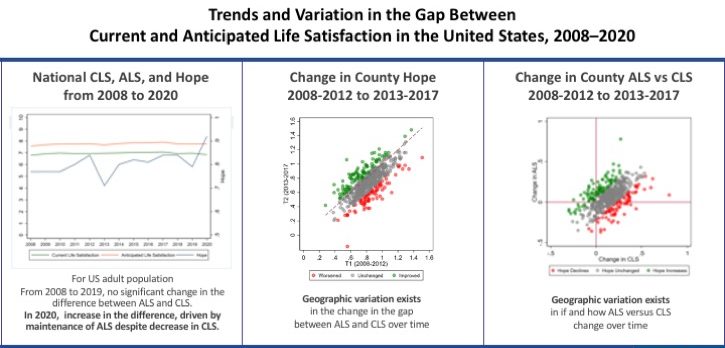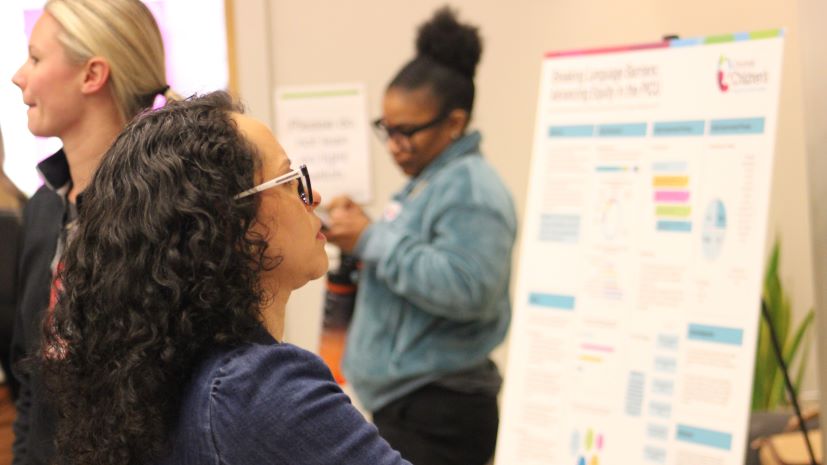In 2020, Americans Maintained Sense of Hope—Despite COVID-19 Pandemic
Research By: Carley Riley, MD, MPP, MHS
Post Date: February 23, 2022 | Publish Date: Feb. 23, 2022

Among the devastating consequences of the COVID-19 pandemic, researchers found a surprisingly optimistic outcome—in 2020, most adults in the United States retained a sense of hope for the future.
A team led by Carley Riley, MD, MHS, Division of Critical Care Medicine, set out to investigate trends and variations in hope among Americans from 2008 to 2020. Responses from nearly 2.8 million participants show that for many, hope remained the same—until 2020, when hope increased.
The findings, published Feb. 23, 2022, in the American Journal of Public Health (AJPH), provide a rare, comprehensive look at the gap between current life satisfaction and anticipated life satisfaction in the United States.
“Our results demonstrate that on average, U.S. adults maintained anticipated life satisfaction in 2020, despite significant decline in current life satisfaction amidst the pandemic,” says Riley. “This sustained sense of hope for the future could be a potential strength or asset to be leveraged, though the decline in current life satisfaction demands attention and action.”
What Does ‘Hope’ Mean?
From person to person, hope can take on different meanings, but the commonality is an expectation that things will get better. Hope enables us to persist and proceed toward our goals.
Increasingly, we are beginning to understand just how much hope affects our quality of life. When we have greater hope, we experience better physical and mental health outcomes, health-related behaviors, emotional well-being, social relationships and support, and life satisfaction.
In the United States, increased mortality due to “deaths of despair”—including suicide, drug overdose, and alcohol-related conditions—has led to declines in life expectancy. Now, the COVID-19 pandemic has further heightened concerns about hope and the potential consequences of its decline.
“Promoting population hope requires knowledge of how it is changing over time and how it varies across the country,” says Riley. “Responding to these trends is essential for the collective health and well-being of our nation, especially as we navigate and emerge from crisis.”
How Can We Measure Hope?
Despite the importance of understanding population hope, the United States currently lacks national data, trends, and benchmarks on hope over time. To address this gap, Riley—along with a team of scientists from Cincinnati Children’s, Yale School of Medicine, and Gallup who specialize in collective well-being and its determinants—turned their attention to hope.
First, the team developed a new way to measure hope. They started with data from the Gallup National Health and Well-Being Index (WBI), the largest multi-year dataset on life evaluation in the United States. Next, they applied the Cantril Self-Anchoring Striving Scale, a questionnaire designed to assess people’s attitudes toward their current and future life. Then, they calculated the difference between current life satisfaction and anticipated life satisfaction to summarize population hope.
From 2008 through 2019, researchers found that the gap between anticipated and current life satisfaction remained stable nationally. From 2008 to 2017, this measure remained unchanged in many counties and showed variation in others.
Then in 2020, hope increased—an unexpected outcome, as researchers hypothesized a decrease due to the pandemic. Although participants did feel worse about their current lives, they retained hope that things would improve. Still, a closer look at the data reveals inequities among Americans in different parts of the country.
“At the county level, our analysis shows that over time—even prior to the onset of the pandemic—the difference between anticipated and current life satisfaction declined in nearly one out of every seven counties, while both anticipated and current life satisfaction declined in nearly one out of every 11 counties,” says Brita Roy, MD, MPH, MHS, director of population health at Yale School of Medicine. “These findings suggest that declines in well-being and hope were concentrated in particular counties across the US and may point to geographic populations exposed to detrimental systemic or structural factors.”
What Can We Do to Increase Hope?
If local factors do play a part in these trends, they may offer meaningful opportunities for intervention—rebuilding hope for people and places across the US.
To work towards this goal, study authors assert the importance of timely data on hope at national and local levels. The team plans to conduct qualitative assessments of their findings and identify actionable determinants of hope.
“In order to improve hope, we likely need to intervene on novel population targets, including sense of purpose, civic engagement, and quality of social relationships,” says Riley. “And certainly, given that structural factors such as lack of economic opportunity and racism are assuredly contributing to stagnation, variation, and declines in hope, our collective progress will require systemic transformation.”
| Original title: | Trends and Variation in the Gap Between Current and Anticipated Life Satisfaction in the US, 2008-2020 |
| Published in: | American Journal of Public Health |
| Publish date: | Feb. 23, 2022 |
Research By








